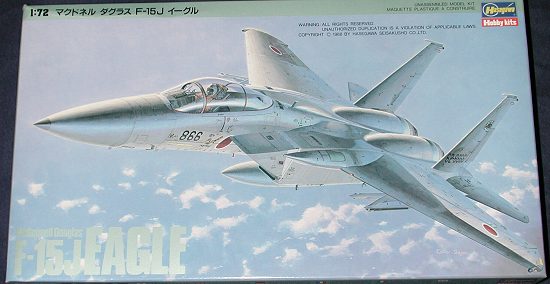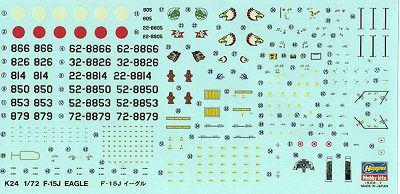
|
KIT: |
Hasegawa 1/72 F-15J Eagle |
|
KIT # |
K 24 |
|
PRICE: |
$29.95 |
|
DECALS: |
Just about every JASDF Squadron |
|
REVIEWER: |
|
|
NOTES: |
This is the newer tool from 1988 |

|
HISTORY |
The biggest success story for McDonnell/Douglas after the F-4 was the F-15 Eagle. Now it is the F-18, but that is another story. The current F-15E is still slowly coming off the (now) Boeing production lines in St. Louis thanks to heavy lobbying to keep St. Louis aerospace workers employed (you may thank your congressman and the unions who paid for him for that). What is unique about the F-15A/C versions is that they are still being used solely as fighter/interceptors. You want a bomber F-15, then use the Strike Eagle. Even the highly touted F-14 was converted over to the bomber role about 10 years ago, much to the disgust of its crew.
Unlike the F-16, the Eagle is not a relatively simple aircraft. The skills needed to keep it flying are a bit higher than what is required for the Falcon. It is also a much more expensive aircraft. For that reason, it has seen little in the way of export sales. Only Japan, Israel and Saudi Arabia have the F-15 in their arsenal. Those Saudi-flown planes are basically maintained by US civilian support teams as the Saudis are not know to want to do anything for themselves that they can pay others to do for them. The Israelis have the Eagle as they have a very strong lobby in the US that buys all sorts of politicians to make sure they have the latest and greatest. The Japanese have the Eagle as they also bought a production license for the plane (after the usual exchange of funds and favors), a typical move for the Japanese when it comes to aircraft or any other large business deal. Other countries have wanted the plane, but couldn't justify the cost of it and opted for the F-16 instead, which in most cases, was really the best move for them to have a capable, modern, multi-mission aircraft.
On a totally different note, it is rumored that the next drone after all the F-4s are gone will be either the F-18 or the F-15. Both aircraft have two of the main requirements for a drone nowadays; strong landing gear and two engines. Both types have substantial airframes in the boneyard at this time. All of the 73- and 74- year F-15As are at D-M as are a number of 75-,76- and 77- models. Those remaining are with various ANG units and have had the MSIP modification done to them that brings all the avionics up to or exceeding F-15C levels. Those states flying the F-15A MSIP are Missouri, Florida, Massachusetts, Oregon, Louisiana, and Hawaii (I don't think I missed any). These are all doing air defense roles, and you'll notice that except for Missouri (which is right across the runway from the factory), the others are in coastal or near-coastal locations. Even with the F-22 slowly coming on line, you'll be seeing and hearing F-15s for several more decades!
|
THE KIT |

Hasegawa has issued several F-15 kits over the years. The first one was a prototype aircraft with the squared wing tips. It was quite basic with raised panel lines and minimal detail. However, that was expected from a kit in the early 1970s. This kit was later modified with the cut back wing tips, larger speed brake and proper fins with the right sized anti-flutter weights on the tips. In 1988 a new kit was issued. The first boxing was this one for the home market. It was also released in a USAF version a short time later, and has been reissued a number of times since then. A two seater has also been done with a change in small square sprue in the lower center of the picture above that has the B/D bits in it.
The kit has the expected nicely engraved panel lines, a well done cockpit with engraved instrument panel and console detail, nice detail in the wheel wells, etc, etc. It is also built to the modular concept that allows several different versions to be done with one kit. Fortunately for us, the Eagle has not been heavily modified until one gets to the E model, so all the fiddly stuff is kept to a minimum. This kit offers exhaust that are sans the 'turkey feather' coverings. These were removed from USAF Eagles after it was discovered that they were of little use and caused maintenance problems. This means that you can build this kit as a USAF bird with almost no mods. Actually, a substantial percentage of the parts count is the afterburner nozzle assembly. It is equally nice that the USAF fin with the DECM receiver in it is also included in the kit
Options are somewhat minimal. One is that you can put decals in place of the
instruments should you choose. You also have the option of installing three fuel
tanks; one on the centerline and the other two hanging from the wing pylons. No
included are any offensive missiles. This is to get you to fork out another $10
or so on the weapons set. You can also display the speed brake in the open
position, but this was almost never seen open while on the ramp. Finally, the
separate canopy and windscreen means that you can pose the canopy open and a
canopy brace is provided for that purpose.
Instructions are the usual excellent Hasegawa offerings with all your colors in Gunze paints and with FS numbers provided where applicable. The rather large decal sheet is festooned with data stencils and offers markings for Eagles with all of the JASDF squadrons flying the plane in 1988. All are painted identically in FS 36320 and 36475, which I believe are light and dark ghost grey, or something like that. It is the rather bland nature of Eagle markings that one doesn't see too many of them built. Fortunately, there are some semi-interesting aftermarket sheets that offer some slightly more interesting markings.
|
CONCLUSIONS |
If you want a really good 1/72 Eagle, this is it. There are others out there by Airfix and Academy, to name a couple, but they are also-rans. You need to be careful when buying the Hasegawa Eagle as the older kit from the 70's is still being offered for sale. The way to tell is that if it seems pretty cheap for a Hase kit, it is the older mold.
If you would like your product reviewed fairly and quickly by a site that has well over 150,000 visitors a month, please contact me or see other details in the Note to Contributors.